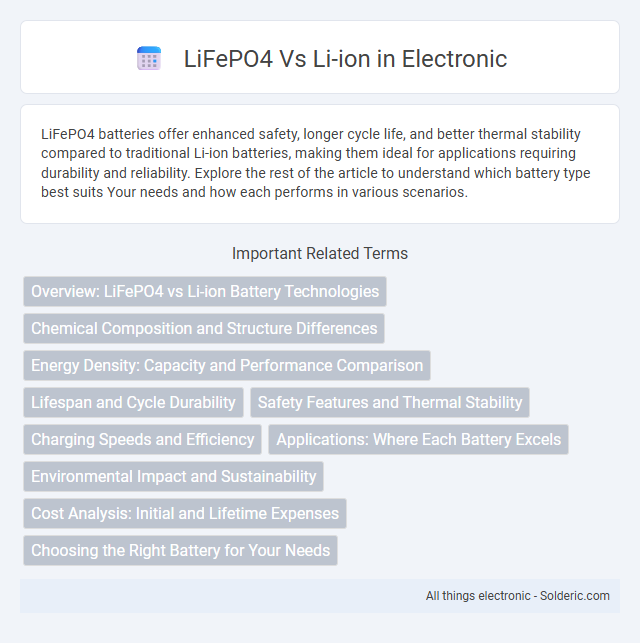LiFePO4 batteries offer enhanced safety, longer cycle life, and better thermal stability compared to traditional Li-ion batteries, making them ideal for applications requiring durability and reliability. Explore the rest of the article to understand which battery type best suits Your needs and how each performs in various scenarios.
Comparison Table
| Feature | LiFePO4 (Lithium Iron Phosphate) | Li-ion (Lithium-ion) |
|---|---|---|
| Battery Chemistry | Lithium Iron Phosphate (FePO4) | Lithium Cobalt Oxide, Lithium Manganese Oxide, or other variants |
| Energy Density | 90-120 Wh/kg | 150-250 Wh/kg |
| Cycle Life | 2000-5000 cycles | 500-1500 cycles |
| Safety | Highly stable, low risk of thermal runaway | Moderate risk of overheating and thermal runaway |
| Voltage | 3.2-3.3 V per cell | 3.6-3.7 V per cell |
| Cost | Lower cost per cycle, higher initial cost | Lower upfront cost |
| Temperature Range | -20degC to 60degC | 0degC to 45degC |
| Weight | Heavier due to lower energy density | Lighter, compact for size |
| Applications | Electric vehicles, solar storage, backup power | Consumer electronics, electric vehicles, portable devices |
Overview: LiFePO4 vs Li-ion Battery Technologies
LiFePO4 batteries offer superior thermal stability, longer cycle life, and enhanced safety compared to traditional Li-ion batteries, which typically deliver higher energy density and lighter weight. These advantages make LiFePO4 ideal for applications requiring durability and safety, such as electric vehicles and energy storage systems. Your choice depends on whether you prioritize energy capacity or longevity and safety in battery performance.
Chemical Composition and Structure Differences
LiFePO4 (lithium iron phosphate) batteries utilize an olivine crystal structure with iron, phosphate, and lithium ions, providing high thermal stability and structural integrity. In contrast, Li-ion batteries mainly use layered metal oxides like lithium cobalt oxide with cobalt, nickel, or manganese, enabling higher energy density but lower thermal and chemical stability. The phosphate groups in LiFePO4 contribute to safer cycling and longer lifespan by resisting degradation compared to the more reactive oxide compounds in typical Li-ion chemistries.
Energy Density: Capacity and Performance Comparison
LiFePO4 batteries offer a lower energy density, typically around 90-120 Wh/kg, compared to Li-ion batteries that range from 150-250 Wh/kg, making Li-ion cells preferable for applications requiring higher capacity and longer runtimes. Despite the lower energy density, LiFePO4 batteries provide superior thermal stability, longer cycle life, and enhanced safety, maintaining consistent performance over more charge-discharge cycles. Choosing the right battery depends on whether Your priority lies in maximizing energy storage or optimizing durability and safety for specific use cases.
Lifespan and Cycle Durability
LiFePO4 batteries offer superior lifespan and cycle durability, often exceeding 2,000 to 5,000 charge cycles compared to standard Li-ion batteries, which typically provide 300 to 1,000 cycles. The robust phosphate-based cathode in LiFePO4 chemistry contributes to enhanced thermal stability and reduced capacity fade over time, making it ideal for applications requiring long-term reliability. Li-ion batteries, while having higher energy density, tend to degrade faster under high charge-discharge rates and elevated temperatures, limiting their overall cycle life.
Safety Features and Thermal Stability
LiFePO4 batteries exhibit superior safety features and thermal stability compared to traditional Li-ion batteries due to their stable phosphate-based cathode structure, which resists overheating and reduces the risk of thermal runaway. The intrinsic chemical stability of LiFePO4 cells enables them to operate safely at higher temperatures and improves their resistance to combustion or explosion under extreme conditions. These safety advantages make LiFePO4 batteries ideal for applications requiring robust thermal management and enhanced protection against fire hazards.
Charging Speeds and Efficiency
LiFePO4 batteries offer slower charging speeds compared to traditional Li-ion batteries but excel in maintaining higher charging efficiency over extended cycles. Li-ion cells can charge faster, reaching up to 80% capacity in under 30 minutes with advanced chargers, while LiFePO4 typically requires 2-3 hours for a full charge due to its stable chemistry. The enhanced thermal stability and reduced degradation of LiFePO4 result in better long-term energy efficiency, making it ideal for applications needing durability over rapid charge times.
Applications: Where Each Battery Excels
LiFePO4 batteries excel in applications requiring thermal stability and long cycle life, such as electric vehicles, solar energy storage, and backup power systems. Li-ion batteries offer higher energy density, making them ideal for portable electronics, laptops, and smartphones where compact size and weight are critical. Each battery type's chemistry dictates its suitability, with LiFePO4 favored for safety and longevity, while Li-ion is preferred for energy-intensive devices demanding rapid energy delivery.
Environmental Impact and Sustainability
LiFePO4 batteries offer a more environmentally friendly alternative to traditional Li-ion batteries due to their non-toxic phosphate-based cathode and longer lifecycle, reducing waste and resource consumption. Unlike Li-ion batteries, LiFePO4 cells demonstrate higher thermal stability and lower risk of hazardous material leakage, minimizing ecological hazards. The sustainable sourcing of lithium and iron phosphate, combined with enhanced recyclability, makes LiFePO4 technology a preferable choice for reducing environmental impact in energy storage.
Cost Analysis: Initial and Lifetime Expenses
LiFePO4 batteries typically have a higher initial cost compared to conventional Li-ion batteries due to specialized materials and manufacturing processes. However, LiFePO4 offers a longer lifespan with more charge-discharge cycles, reducing replacement frequency and overall lifetime expenses. Assessing your energy needs and usage patterns helps determine which battery type provides better cost efficiency over time.
Choosing the Right Battery for Your Needs
LiFePO4 batteries provide enhanced safety, longer cycle life exceeding 2000 cycles, and thermal stability ideal for stationary energy storage and electric vehicles, while Li-ion batteries offer higher energy density suitable for portable electronics and applications requiring compact power sources. Evaluating factors such as energy density, weight, lifespan, and safety requirements is crucial when selecting between LiFePO4 and Li-ion technologies. Prioritize LiFePO4 for durability and safety in heavy-duty or long-duration use, and Li-ion when minimizing size and maximizing energy output is essential.
LiFePO4 vs Li-ion Infographic

 solderic.com
solderic.com